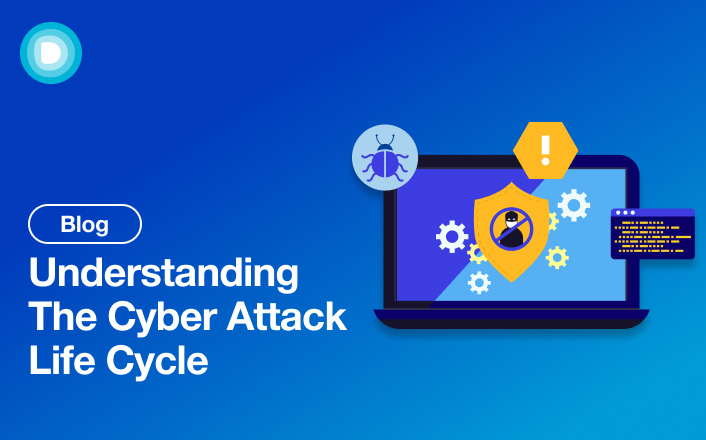- Product
-
Solution
-
By Industry
Cybersecurity solutions tailored to your industry’s needs.
-
- Resources
-
Books
Our ultimate guides and playbooks
Solution Briefs
Overview of PureDome’s functionality
-
Quizzes
Assess your cybersecurity readiness
Case Studies
PureDome customer success stories
Newsletter
Subscribe to the PureDome newsletter
-
- About Us
- Partner
- Pricing
- Download
Understanding The Cyber Attack Life Cycle
-
Aiman Ikram
-
17 May 2024
- 3 min read


When cyber attackers try to steal data from a network, they follow a series of steps called the cyber attack lifecycle. To stop them, defenders need to disrupt these steps at any point. This involves stopping attackers from entering the network and stealing the data.
This blog discusses the different stages of a cyber attack lifecycle and how the cycle can be broken to help secure your network.
What is the Cyber Attack Life Cycle?
The Cyber Attack Lifecycle is the process cyber attackers follow to steal data from a network. It starts with gathering information and then breaking into the network using tricks like phishing or finding security flaws. Once they're in, they install malware to stay in the system. They then try to gain more access and move around the network to find important data. In the final step, they steal the data. At each stage, defenders have chances to stop the attack and protect the network.
Key Insights: Cyber Attack Life Cycle
Average Duration: In 2023, the average cyberattack lifecycle in North America lasted about 24 days.
Detection and Containment: On average, companies took 197 days to identify and 69 days to contain a breach, according to IBM.
Increase in Costs: The average cost of a cyberattack has risen by 15% over the past three years, reaching $4.45 million in 2023.

Stages of the Cyber Attack Lifecycle
These are the 6 stages of the cyber attack life cycle:
Reconnaissance:
In the first stage, known as reconnaissance, attackers gather crucial information about their target. This could include details about the organization's infrastructure, employees, and potential vulnerabilities.
Attackers often scour public sources, like social media and company websites, to piece together this information. They may also conduct scans to identify weak points in the network. The purpose of reconnaissance is to lay the groundwork for the attack by identifying potential entry points into the target's systems.
Initial Compromise:
Once armed with information, attackers proceed to the stage of initial compromise. Here, they exploit vulnerabilities discovered during reconnaissance to gain unauthorized access to the target's network. Common methods include phishing emails, malware injections, or exploiting software vulnerabilities. By gaining a foothold in the network, attackers set the stage for further infiltration and data theft.
Establishing a Foothold:
Having breached the network, attackers work to establish a more permanent presence. They install backdoors or malware that allow them to maintain access even if their initial point of entry is discovered and closed off. This stage, known as establishing a foothold, is crucial for maintaining control over the compromised systems and ensuring continued access for future activities.
Escalating Privileges:
With a foothold established, attackers seek to escalate their privileges within the network. This involves gaining access to higher-level accounts or administrative privileges, granting them greater control over critical systems and sensitive data. Attackers may employ various techniques, such as password cracking or exploiting vulnerabilities in software, to achieve this goal.
Internal Reconnaissance:
Armed with elevated privileges, attackers conduct internal reconnaissance to further explore the network. They map out the network topology, identify valuable assets, and gather intelligence on potential targets. This stage allows attackers to plan their next moves strategically, identifying the most lucrative targets for data theft or sabotage.
Lateral Movement and Data Exfiltration:
In the final stages of the attack lifecycle, attackers move laterally through the network, expanding their reach and accessing additional systems and data repositories. They may employ tools and techniques to evade detection while exfiltrating sensitive data from the network. This could include intellectual property, financial records, or personally identifiable information (PII). The ultimate goal is to complete their mission and exploit the stolen data for financial gain or other malicious purposes.
Strategies to Disrupt the Cyber Attack Lifecycle
Zero Trust Network Access (ZTNA): ZTNA limits access to network resources based on strict verification of user identity and device health. It helps prevent attackers from moving laterally within the network by restricting access to only authorized users and devices.

Regular Software Updates: Updating software regularly patches known vulnerabilities, making it harder for attackers to exploit weaknesses in the system.
Employee Training: Educating employees about cybersecurity risks and how to recognize phishing attempts can help prevent initial compromises by reducing the likelihood of users falling for social engineering tactics.
Network Segmentation: Segmenting the network into smaller, isolated zones limits the spread of an attack, making it harder for attackers to move laterally and access sensitive areas of the network.
How PureDome Helps
PureDome keeps your network safe by blocking threats, like cyber attacks and harmful content. It watches what's going on and alerts you if something seems fishy. Plus, it protects all your devices from getting hacked. So, with PureDome’s security suite, your network stays secure and your data stays safe.
Frequently Asked Questions
What is the cyber attack lifecycle?
The cyber attack lifecycle outlines the stages attackers follow to breach a network, from reconnaissance to data exfiltration.
How can defenders disrupt the cyber attack lifecycle?
Defenders can disrupt the cyber attack lifecycle by implementing measures like zero trust network access, regular software updates, employee training, and network segmentation.
How does PureDome contribute to network security?
PureDome enhances network security by blocking threats, monitoring network activity, and safeguarding devices against cyber attacks.